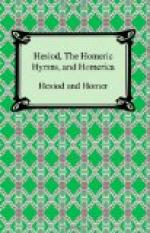Hesiod’s diction is in the main Homeric, but one of his charms is the use of quaint allusive phrases derived, perhaps, from a pre-Hesiodic peasant poetry: thus the season when Boreas blows is the time when `the Boneless One gnaws his foot by his fireless hearth in his cheerless house’; to cut one’s nails is `to sever the withered from the quick upon that which has five branches’; similarly the burglar is the `day-sleeper’, and the serpent is the `hairless one’. Very similar is his reference to seasons through what happens or is done in that season: `when the House-carrier, fleeing the Pleiades, climbs up the plants from the earth’, is the season for harvesting; or `when the artichoke flowers and the clicking grass-hopper, seated in a tree, pours down his shrill song’, is the time for rest.
Hesiod’s charm lies in his child-like and sincere naivete, in his unaffected interest in and picturesque view of nature and all that happens in nature. These qualities, it is true, are those pre-eminently of the “Works and Days”: the literary values of the “Theogony” are of a more technical character, skill in ordering and disposing long lists of names, sure judgment in seasoning a monotonous subject with marvellous incidents or episodes, and no mean imagination in depicting the awful, as is shown in the description of Tartarus (ll. 736-745). Yet it remains true that Hesiod’s distinctive title to a high place in Greek literature lies in the very fact of his freedom from classic form, and his grave, and yet child-like, outlook upon his world.
The Ionic School
The Ionic School of Epic poetry was, as we have seen, dominated by the Homeric tradition, and while the style and method of treatment are Homeric, it is natural that the Ionic poets refrained from cultivating the ground tilled by Homer, and chose for treatment legends which lay beyond the range of the “Iliad” and “Odyssey”. Equally natural it is that they should have particularly selected various phases of the tale of Troy which preceded or followed the action of the “Iliad” or “Odyssey”. In this way, without any preconceived intention, a body of epic poetry was built up by various writers




